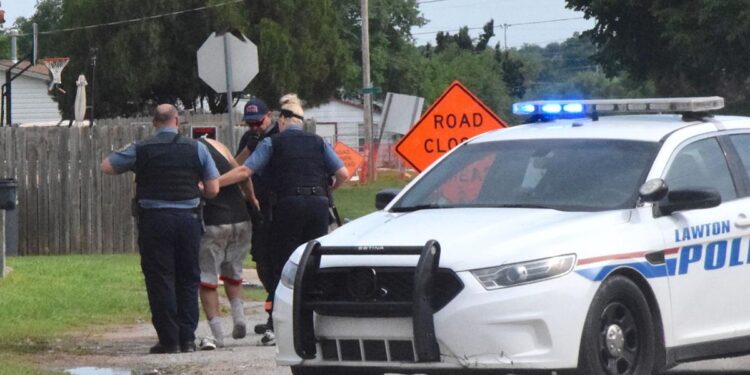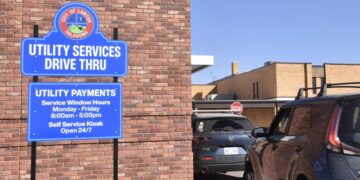You don’t want to think of it.
But in the event of the worst-case scenario, first responders need to know what to do and how to do it safely when a natural disaster erupts into an industrial disaster. It helps to know how to do your part, as well.
A Wednesday discussion during the quarterly Local Emergency Planning Committee led to a discussion about how first responders would need to approach a natural disaster in Lawton’s industrial park.
Located on the city’s southwest side, Goodyear, Republic Paperboard, IPEX Piping Systems and the Westwin Elements cobalt refining pilot plant are among the industrial entities in the mix.
INDUSTRIAL DISASTER PREPARATION
Lawton Fire Chief and LEPC Chairman Jared Williams cited the tornadoes that struck Bartlesville and Sulphur as raising his concerns about the need for the discussion.
The topic goes hand-in-hand with Comanche County-Lawton Emergency Management’s efforts in producing its hazard mitigation plan, according to Deputy Director Alana Pack. Currently under review, the plan comprises comprehensive documentation to hazardous chemicals housed at the industrial businesses as well as projects the biggest future hazardous impacts.
Representatives from the industrial entities said they have their paperwork and internal plans together although some need more in-depth. A representative from Westwin said its plans are in the diligence process and will be together by its expected August opening of production.
Looking back to the June 2023 tornado and hail damage that hit Lawton, Williams said it led to him imagining if it had struck the industrial area. Often those types of incidents happen when there are a number of firefighters, for example, who are off-duty who would have to return to service.
“We’re immediately overwhelmed,” he said. “We have to manage resources in the industrial areas. … We need industry able to assist.”
This is where the connection between these many entities becomes most important, according to Williams.
But there’s more than one type of disaster scenario for emergency responders to consider.
IT TAKES TIME TO RESPOND
In the wake of any large natural disaster there’s an expectation for emergency response that has to be met by the reality that heroes are human.
City of Lawton Streets Superintendent Cliff Haggenmiller said one thing everyone needs to know is there will be delay. For his department, the responsibility is to give responders the ability to get to the disaster zone.
For police, there’s not much they can do in the midst of a situation such as a tornado, said Lawton Police Lt. Justin Thorne.
“You can’t battle that,” he said. “We position right behind and move into action as quick as we can, but there will be delay.”
Williams said the public wants a response instantly. But the safety of responders and their families are equally important.
“These things take time,” he said. “We can’t do it if we’re taken out.”
This means educating the public, Pack said. She spoke of last year’s tornado as well as other emergencies where power was lost for an extended amount of time. She believes public outreach and education opportunities can allow the citizens to help and become part of the solution.
“How do we build our citizens to be resilient those first 72 hours?” she said. “It’s called, ‘the first 72 is on you.’”
YOU AS CITIZENS CAN HELP
Pack’s department has been using its social media pages to help people know how to be prepared.
“The goal is to educate,” she said.
Regional Medical Response System Region 3 Director Bob Stewart said companies can set up Community Emergency Response Team training. As part of FEMA, the CERT program offers a consistent, nationwide approach to volunteer training and organization that professional responders can rely on during an emergency.
Stewart said people can take 16 hours of CERT training online for development skills and, to become certified, another eight hours hands-on training. It allows the public to be able to become involved in search and rescue and shelter operations, for example. It’s in development at this time, he said.
There is also an “Until Help Arrives” campaign page with a video available online, Stewart said: https://community.fema.gov/PreparednessCommunity/s/until-help-arrives?language=en_US.
You can call for dates to attend hands-on-training, 580-280-1006.
In the end, Williams said Wednesday’s discussion offered a great start to making real moves in preparedness. Now, it’s up to educating the public while working out the specifics.
“We need the public to be realistic in understanding response, it’s going to take time to get there,” he said. “But when we do, we can handle it.”
Want to reach a local audience and grow your business?
Our website is the perfect platform to connect with engaged readers in your local area.
Whether you're looking for banner ads, sponsored content, or custom promotions, we can tailor a package to meet your needs.
Contact us today to learn more about advertising opportunities!
CONTACT US NOW





